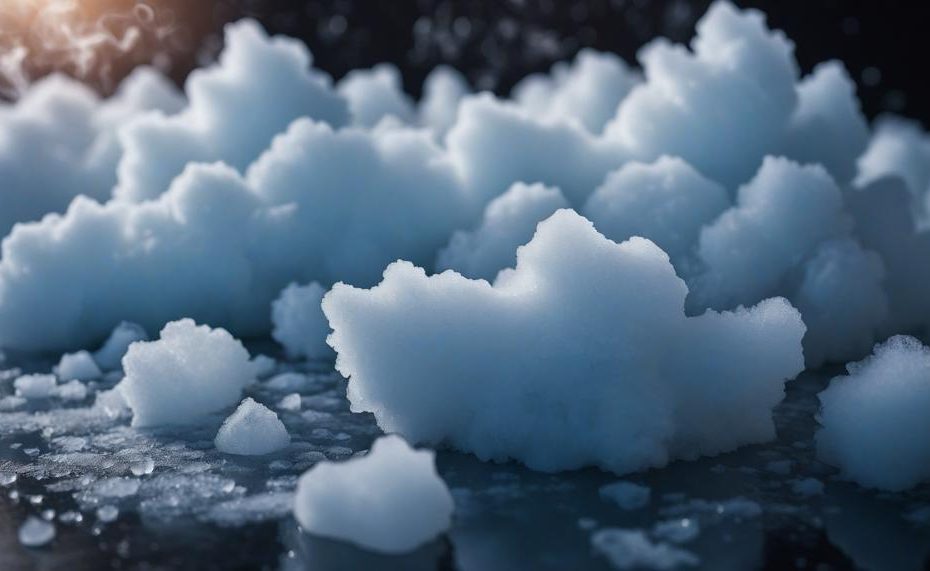Disposing of dry ice might seem straightforward, but doing it safely requires some know-how. Dry ice, or solid carbon dioxide, is a popular choice for keeping things cold during transport and creating special effects.
However, its extremely low temperature and sublimation process—where it turns directly from solid to gas—can pose hazards if not managed correctly. Here’s a quick guide to help you dispose of dry ice safely and efficiently.
Key Takeaways:
- Sublimate Naturally: Let small amounts of dry ice sublimate in a well-ventilated area. This avoids dangerous gas build-up.
- Use Warm Water: Accelerate sublimation by placing dry ice in warm water. Remember to handle it with gloves or tongs to prevent burns.
- Contact Waste Management: For large quantities, your local waste management company can provide specific disposal instructions.
- Transport with Care: If you need to move dry ice, use a ventilated container and avoid sealed bags to prevent pressure build-up.
By following these simple steps, you can ensure that your dry ice disposal is safe for both you and the environment. Now, let’s dive deeper into the specifics of each method.
Contents
- 1 Understanding the Basics:What is Dry Ice?
- 2 Where to Buy Quality Dry Ice:Your Ultimate Guide
- 3 The Many Uses of Dry Ice:Beyond the Ordinary
- 4 Dry Ice Storage Tips:Keeping it Safe and Effective
- 5 Step-by-Step:How to Dispose of Dry Ice Safely
- 6 Dry Ice Safety Precautions:What You Need to Know
- 7 Fun Experiments with Leftover Dry Ice
- 8 Conclusion
Understanding the Basics:What is Dry Ice?
Dry ice, or solid carbon dioxide (CO₂), is widely used for cooling and creating fog effects due to its extremely low temperature of -109.3°F (-78.5°C). Understanding its properties is vital for safe handling and disposal.
| Property | Description | Safety Considerations |
| Sublimation | Dry ice turns directly from a solid to a gas, bypassing the liquid phase. | Dispose of it in a well-ventilated area to avoid dangerous CO₂ build-up. |
| Temperature | Extremely cold at -109.3°F (-78.5°C). | Handle with insulated gloves to prevent severe frostbite-like burns. |
| Density | Heavier than air when it sublimates. | Ensure proper ventilation to prevent CO₂ accumulation, which can displace oxygen. |
Safe Disposal Methods
- Natural Sublimation: Leave dry ice in a well-ventilated room at room temperature. This method can take 24-48 hours, depending on the quantity.
- Warm Water: Speed up sublimation by placing dry ice in warm water. Handle with gloves or tongs to avoid burns.
For large amounts, contact local waste management services for specific disposal guidelines. Transporting dry ice requires a ventilated cooler to prevent CO₂ gas build-up.

Where to Buy Quality Dry Ice:Your Ultimate Guide
The top locations to purchase high-quality dry ice include grocery stores, online delivery services, and specialized suppliers. Here’s a detailed breakdown:
| Source | Advantages | Considerations |
| Grocery Stores |
|
|
| Online Delivery Services (e.g., Dry Ice Corp, Dry Ice Delivered) |
|
|
| Specialized Suppliers (e.g., Continental Carbonic) |
|
|
Choosing a Supplier: Key Factors
When selecting a supplier, consider:
- Location: Proximity to your location for convenience and reduced shipping costs.
- Quantity Needed: Ensure the supplier can meet your demand, whether small or large.
- Cost: Compare prices, including any shipping fees, to find the best deal.
- Types of Dry Ice: Depending on your needs, choose between blocks, pellets, or slices.
- Supplier Reputation: Opt for trusted suppliers like Continental Carbonic for quality assurance, especially for food-grade applications.
The Many Uses of Dry Ice:Beyond the Ordinary
Dry ice isn’t just for keeping things cold; it has myriad unique and creative applications that go well beyond simple refrigeration. Here are some inventive ways to use dry ice:
Creating Fog Effects:
Dry ice is perfect for creating eerie fog effects, especially during Halloween.
By placing dry ice in warm water, you can produce thick, low-lying fog that spills over containers, enhancing any spooky scene.
Carbonating Beverages:
You can carbonate homemade beverages using dry ice. By adding small pieces of dry ice to liquids like juice or water, you create a fizzy, refreshing drink.
This method is both fun and educational, demonstrating the process of carbonation.
Pest Control:
Dry ice can be used to control pests, particularly in gardens. Placing dry ice near rodent burrows releases carbon dioxide, which displaces oxygen and forces the pests to leave without using harmful chemicals.
Shrinking Metal:
In metalworking, dry ice is often used to shrink metal parts for easy fitting. Cooling the metal with dry ice causes it to contract, allowing it to fit into tighter spaces.
Once it warms up, it expands back to its original size, securing the fit.
Freezing and Removing Warts:
A less common but effective use of dry ice is in the medical field for cryotherapy. Applying dry ice to warts freezes them, making them easier to remove.
Always seek medical advice before attempting this at home.
Creating Fun Science Experiments:
Dry ice is a staple for various science experiments. Some popular projects include:
- Making Giant Bubbles: Place dry ice in soapy water to create large, spooky bubbles that release a cloud of gas when they burst.
- Mini Rockets: Dropping dry ice into a small container with water and sealing it can create a mini rocket as the pressure builds and the container pops.
- Colourful Explosions: Adding food colouring and dry ice to water can create dramatic, colourful eruptions, making science both fun and educational.
Cleaning with Dry Ice Blasting:
Dry ice blasting is an industrial cleaning process where dry ice pellets are blasted at high speeds to clean surfaces. It is environmentally friendly and leaves no residue, making it ideal for delicate or complicated equipment.
Using as Bait for Mosquito Traps:
Dry ice can attract mosquitoes when used in traps. As dry ice sublimates, it releases carbon dioxide, mimicking the breath of humans and animals and luring mosquitoes into traps.
Preserving Specimens:
In scientific research, dry ice is used to preserve biological specimens. Its low temperature keeps samples frozen and intact for transportation and analysis.
Transporting Perishables:
Dry ice is commonly used to transport perishable goods, such as food and medical supplies, over long distances without the need for mechanical refrigeration.
Dry Ice Storage Tips:Keeping it Safe and Effective
Storing dry ice effectively requires understanding its unique properties and taking appropriate safety measures. Here are the essential steps:
Select the Right Container
Dry ice must be stored in a container that allows gas release to avoid pressure build-up. Use a cooler or an insulated container but never a completely airtight one. A container with thick insulation helps to slow down the sublimation process.
| Container Type | Description | Pros and Cons |
| Cooler (with venting) | Commonly used for transport and short-term storage. Venting allows gas escape. | Effective insulation but allows gradual sublimation. |
| Insulated Box | Thicker insulation for better temperature control. | Longer retention of dry ice, needs to be vented. |
| Plastic Storage Bin (loosely covered) | Temporary solution for smaller amounts. | Convenient but less effective insulation. |
Wrap Dry Ice
Wrapping dry ice in towels or insulating materials helps reduce direct contact with warmer surfaces, slowing down the sublimation process.
Example: Use thick cloth or paper to wrap the dry ice before placing it into the container.
Store in a Ventilated Area
Store the container in a well-ventilated area to prevent the accumulation of carbon dioxide gas. Avoid placing it in closed spaces, cars, or rooms without proper ventilation.
Monitor Temperature
Keep a thermometer handy to monitor the temperature inside the container. Ideal storage conditions maintain a steady, cold environment.
Safety Precautions
- Handle with Care: Always use gloves or tongs when handling dry ice to avoid burns.
- Avoid Ingestion: Keep out of reach of children and pets.
- Do Not Store in Freezers: Standard freezers are not suitable due to the risk of pressure build-up from sublimating CO₂.
Usage Timeline
Dry ice sublimates at about 2-5 lbs per 24 hours in an insulated container. Plan storage duration accordingly to ensure you have enough for your needs.
Step-by-Step:How to Dispose of Dry Ice Safely
Wear Protective Gear
- Use gloves: Always wear thick rubber gloves or oven mitts.
- Use tools: Employ tongs or a scoop to handle dry ice.
Store in a Ventilated Area
- Select the right container: Use an open cooler or a bucket with holes.
- Avoid airtight containers: Prevent explosions by allowing gas to escape.
Allow Natural Dissipation
- Time required: Typically, 24-48 hours depending on the amount and ambient temperature.
- Avoid drains: Do not dispose of dry ice in sinks or toilets as it can damage plumbing.
Dispose of Residue
- Do not touch with bare hands: Use a broom or dustpan to sweep up any residue.
- Label waste: Place residue in a properly labeled plastic bag indicating “dry ice residue.”
Check Local Regulations
- Research guidelines: Some areas have specific disposal rules. Contact local waste management or search online for local protocols.
Dry Ice Safety Precautions:What You Need to Know
When disposing of dry ice, certain safety measures are essential to prevent harm and ensure proper disposal. Here are the key safety precautions:
- Wear Protective Gear: Always use thick gloves and safety goggles to handle dry ice. This prevents frostbite and protects your eyes from splinters or fragments of dry ice.
- Well-Ventilated Area: Allow dry ice to sublimate (turn into gas) in a well-ventilated area. This prevents the buildup of carbon dioxide, which can lead to asphyxiation in confined spaces.
- Do Not Seal in Containers: Never dispose of dry ice in a sealed container. As it sublimates, it creates carbon dioxide gas, which can cause sealed containers to burst due to pressure buildup.
- Avoid Drains and Toilets: Do not flush dry ice down sinks, drains, or toilets. The extreme cold can damage plumbing, and the sublimating gas can cause pipes to crack.
- Check Local Regulations: Consult your local waste management guidelines to ensure you are complying with any specific disposal rules.
- Natural Sublimation: The safest method to dispose of dry ice is to let it sublimate naturally. Place it in a well-ventilated outdoor area where pets and children cannot reach.
Fun Experiments with Leftover Dry Ice
Experimenting with dry ice can be both thrilling and educational. Here are some engaging and safe activities you can try:
| Experiment | Description | Materials Needed |
| Foggy Waterfall | Creating a fog effect by tossing dry ice into hot water. The dry ice sublimates quickly, producing dense fog that cascades over the sides. | Hot water, Dry ice, Large container |
| Crystal Ball Bubbles | Place dry ice in bubble solution and cover with a towel. The resulting bubbles are large and look like crystal balls, filled with mist. | Dry ice, Bubble solution, Bowl, Towel |
| Floating Soap Bubbles | Blow soap bubbles over a container of dry ice. The bubbles will freeze and float, appearing to hover in mid-air. | Dry ice, Soap bubbles, Shallow container |
| Fog-Filled Bubbles | Add dry ice to a bowl of bubble solution to create fog-filled bubbles. When these bubbles pop, they release a burst of fog. | Dry ice, Bubble solution, Bowl |
These experiments are not only fun but also serve as a fantastic way to explore scientific concepts like sublimation and gas expansion. Always remember to handle dry ice with protective gloves and use these methods in well-ventilated areas.
Conclusion
Safely disposing of dry ice requires mindful steps due to its unique properties. Dry ice, or solid carbon dioxide, is widely used for cooling and creating dramatic effects but must be handled with care to prevent hazards. Here’s a practical guide for ensuring safe disposal:
- Natural Sublimation: Allow small amounts of dry ice to sublimate in a well-ventilated space. This method ensures that the carbon dioxide gas dissipates safely without accumulating and posing a risk.
- Use Warm Water: To speed up sublimation, place dry ice in warm water. Always use insulated gloves or tongs to handle dry ice to prevent burns.
- Large Quantities: For disposing of large amounts, contact your local waste management service for specific instructions. They can provide guidance tailored to your needs.
- Transport Safely: When moving dry ice, use a ventilated container to avoid pressure build-up from the gas. Never store dry ice in a sealed container, as this could lead to dangerous explosions.
By following these steps, you can ensure that dry ice is disposed of safely, protecting both you and the environment.





